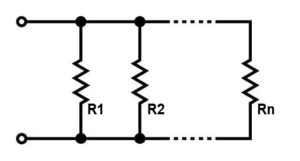This all-in-one online Parallel Resistor Calculator finds the resistance of a circuit consisting of any number of resistors connected in parallel. It can also find the value of the resistor that needs to be connected in parallel with the other resistors to get the necessary total resistance of this circuit.
You can enter the values of any known parameters in the input fields of this calculator and find the missing parameter. To add more resistors you can click the “+” symbol on the right hand side. You can also click the “–” symbol to delete extra lines.
Parallel Resistors Formula
Resistors are in parallel if they are connected to the same two points of an electrical circuit. Parallel resistors can be represented as the following diagram, where \(R_{1}\), \(R_{2}\), …, \(R_{n}\) are the resistance values of the resistors connected in parallel.

An important property of a circuit consisting of resistors connected in parallel is that they share the same voltage on their terminals. This means that according to Ohm’s law, the electric current flowing through each resistor is equal to the ratio of that common voltage to the resistance value of the resistor itself.
Obviously, the total current flowing through the parallel resistors is equal to the sum of the currents through the individual resistors. From this it is easy to show that the following formula is valid for the total equivalent resistance \(R_{T}\) of the entire circuit of resistors connected in parallel:
$$\frac{1}{R_{T}} = \frac{1}{R_{1}} + \frac{1}{R_{2}} + … + \frac{1}{R_{n}}.$$
In other words, the reciprocal of the total resistance of all resistors connected in parallel is equal to the sum of the reciprocals of the resistances of these resistors. It is easy to see that the total resistance will always be less than the value of the smallest resistance.
In practice, it is sometimes necessary to find the resistance value of the resistor that should be connected in parallel with the existing resistor of known resistance to get the necessary total resistance.
The solution to any such problem can be easily found using our Parallel Resistor Calculator.
Related calculators
Check out our other physics calculators such as Ohm’s Law Calculator or Series Resistor Calculator.